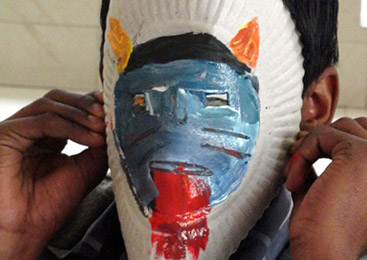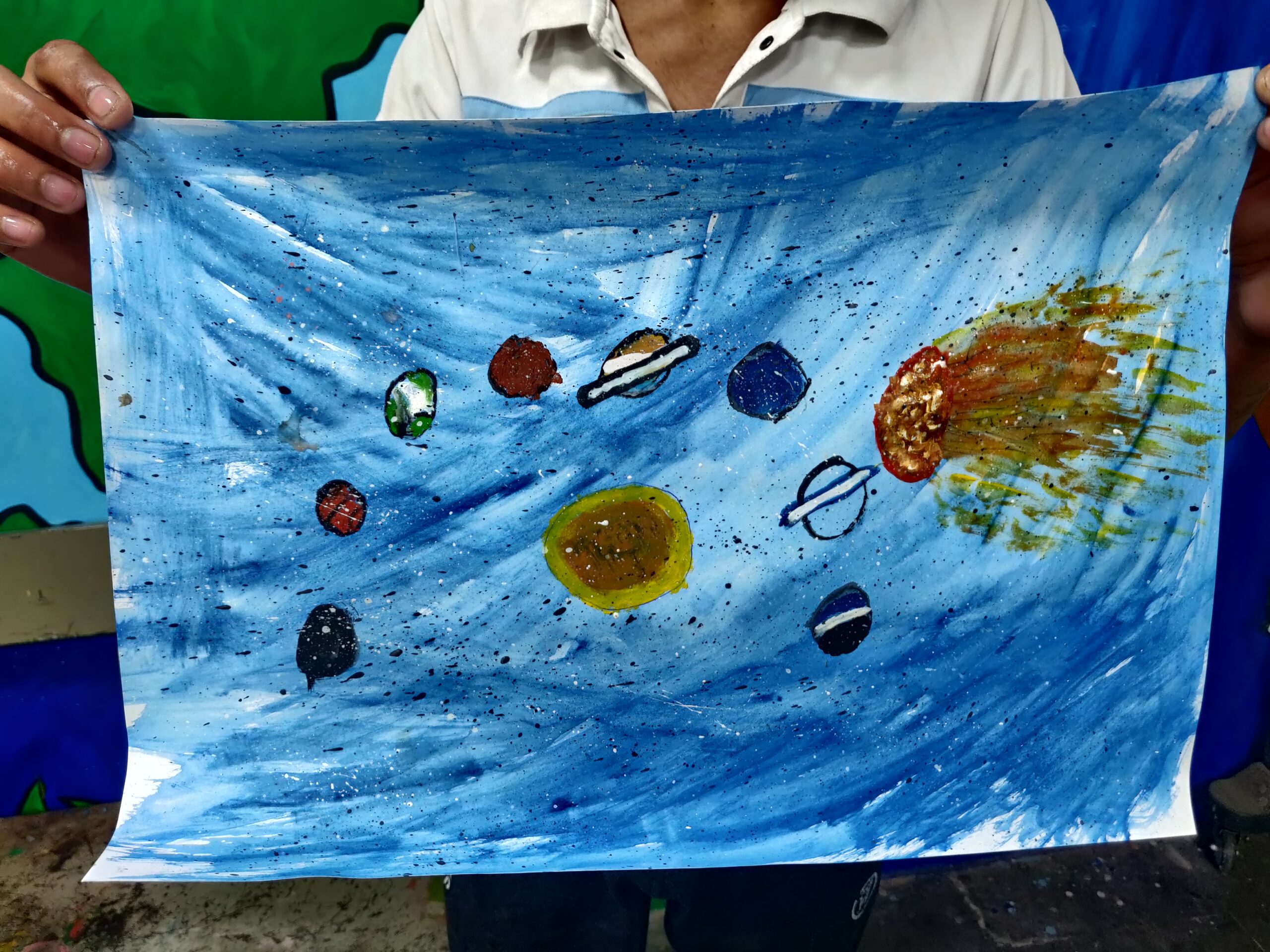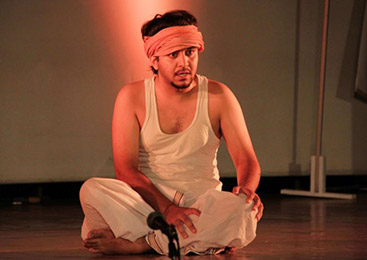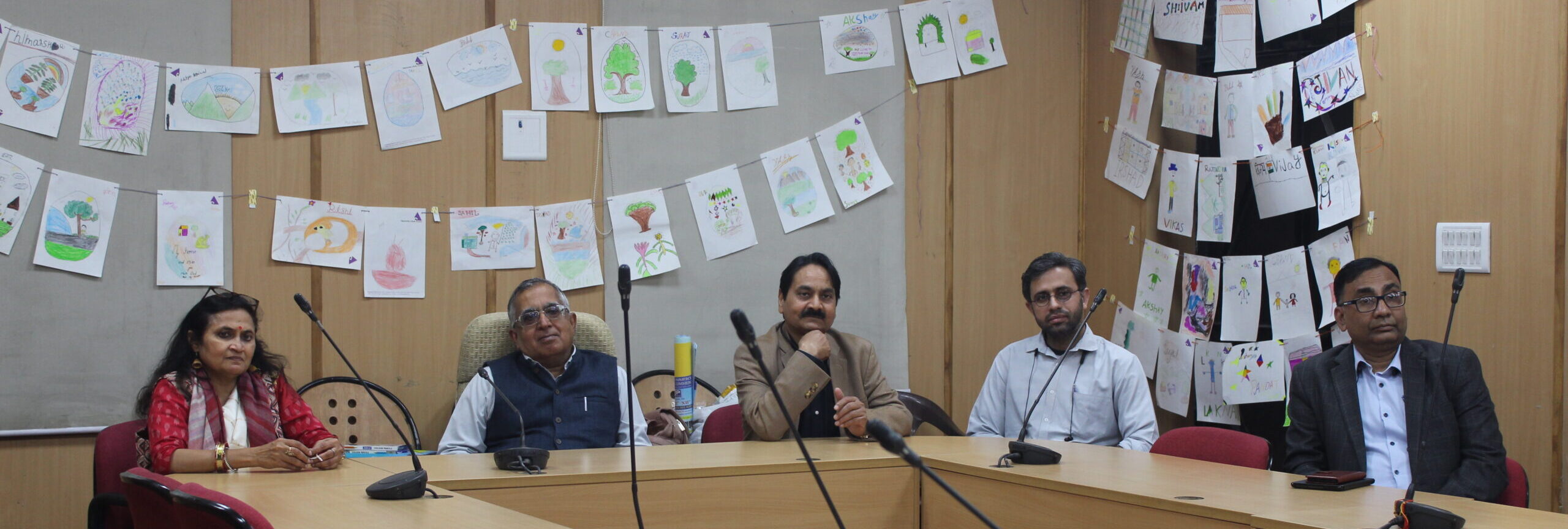‘Swachhta Hi Sewa’ campaign at Observation Home for Boys I
February 10th - March 1st, 2022 Observation Home for Boys - IThe Yuva Ekta Foundation conducted an Expressive Arts and Theatre program at the Observation Home for Boys – I (OHB-1) in Delhi Gate, Delhi, as part of the Swachhta Hi Sewa Campaign. After initial conversations and recce of the venue on February 10, the workshops began on February 14, 2022, and continued till February 28, 2022.
As part of the program, we conducted 12 workshops with over 35 young participants from the Home, that resulted in a theatre performance and an art exhibition as part of the Swachchata Action Plan under the “Mission Vatsalya” scheme. The exhibition was displayed at the Home on March 1, 2022, in front of reputed dignitaries.
The work done as part of this program is based on two metrics. Firstly, we used tools of Expressive Arts and Theatre to enable the participants to journey inwards. Secondly, we focused on ideas of ‘safai’ or cleanliness in our workshops through creative ways.
As part of this program, the boys were exposed to an assorted basket of tools like drawing, dance, physical theatre, body movement, mime, voice-work, creative visualisation, sociometry, psychodrama and group theatre. Through these activities the participants began to explore not only themselves, but also create new relationships with people whom they otherwise seldom interact with.
While the first week was about introducing the participant to basic tools of Expressive Arts and Theatre, we dived deeper into our foray of exercises in the second week. The boys participated in some intense theatre exercises like ‘mirror work’, sociometry, psychodrama, and even began exploring professional choreography with the assistance of our practitioners and facilitators. This not only introduced participants to a new skillset but also aided them in narrating their stories and experiences more creatively. It is through this effort that participants were able to come up with snippets about their life, dreams and aspirations that were ultimately displayed at the exhibition.
The group really enjoyed the dance choreography sessions conducted by Master Practitioner Mr. Avinash Kumar. Dance was an integral part of our sessions and the final theatre performance.
Our workshops stress more on the process than the final creative outcome. The tools and skills learnt during this time can create a significant long term impact. In addition to working towards an exhibition, the boys were also being constantly pushed to work on themselves. The stories and artwork they produced as part of the workshops were completely their own and reflected their reality. We also constantly stressed on our workshops being safe and non-judgemental spaces where participants could express themselves freely, without fear or inhibitions. This aided our transition from the workshop space to the stage since the participants were made to feel comfortable with not only their creative work, but also themselves.
The final exhibiton was displayed at the Conference Hall of OHB-1 on March 1, 2022. The boys performed a play titled ‘Zimmedari Kiski Hai?’ (Whose Responsibility is it?) The play was a collection of snippets from the boys’ lives and also asked questions that the boys had explored through the workshop process. The play ended with a dance that was choreographed under the tutelage of Mr. Avinash Kumar on the song ‘De Mauka Zindagi’ (Give me another chance to Life).
The Exhibition displayed the artwork prepared by the boys as part of the workshop process. Hon’ble Justice R.K. Gauba (Retired Judge, High Court of Delhi), Dr. Rashmi Singh (Director, Department of WCD, Govt. of NCT of Delhi), Ms. Enakshi Ganguly (Child Rights Activist), and Mr. Anurag Kundu (Chairperson, DCPCR), were present at the exhibition
The boys not only performed the play, but also walked the dignitaries of the day through the artwork at the exhibition. The boys felt a sense of pride and achievement in explaining the process behind their creation. The performance and walk through was followed by a question-answer session, where the boys and dignitaries interacted directly, beyond the lens of a case. It is integral to build such equitable platforms for interaction and understanding.
“I like coming to your workshops. When I come here, I forget about all my worries and feel like I am back home. I would like all of you to come more often, even on the weekends”
– Basheer (name changed), a participant in our workshop had this to say to us after the end of our fourth session. His feedback propelled us to keep exploring new possibilities and activities with this group.
“When my peers selected me to be the hero of their story (as part of a sociometry exercise), I felt a sense of confidence and pride. It helped me to understand the language of love.”
– Veeru (name changed), said this towards the end of our workshop process, expressing the impact the workshops have had on him. He was smiling as he said this, telling us that love is more powerful than anger.
The workshops have been both, intense and enriching. The boys have moved leaps and bounds in a span of two weeks, exploring various art forms and concepts of cleanliness. However, we feel that only a part of the work has been done, and a lot more needs to go into working with the boys staying at the Home. The boys who have participated in the workshops, have acquired a unique skillset that enables them to be changemakers in their immediate circles. Young ambassadors or ‘Bal Mitras’ will carry the message of cleanliness forward.
Keeping our learnings in mind, we would like the opportunity to work more regularly in OHB-1 with both the children and the Staff. We feel that Child Care Institutions offer a challenging working environment given the nature of work and responsibilities at hand. Expressive Arts activities have been known to enable a more harmonious working culture that is beneficial for all stakeholders involved.
MORE ARTICLE FROM OUR BLOG

Volunteer’s Diary- Sahyog
Entering the gates of Sahyog campus triggered a series of emotions in me. Was it anxiety or fear or anger or compassion or curiosity? I don’t know! I entered the campus with an empty mind. I tried not to have any presumed notions about these juvenile offenders. The term ‘juvenile’ is used for person below the age of 18, accused in any crime. Having worked with children before, I believe these children were a little different. However, they were and they did behave like any other child of their age group would have.
Freud’s Psychoanalytic theory suggests that personality is mostly established by the age of five. Early experiences play a large role in personality development and continue to influence behaviour later in life. If these psychosexual stages are completed successfully, the result is a healthy personality. If certain issues are not resolved at the appropriate stage, fixation can occur. Perhaps, this issue makes them different from other children. Dysfunctional family, certain incidents, addiction, poverty, illiteracy, lack of guidance affects them.
Consequently, I was there to grasp and learn all I could, therefore I did not want to talk or do anything. I did not want to interrupt their activities. I just wanted to observe. Observe their actions, reactions.
I was amazed to learn how they had perceived of me as their ‘female’ volunteer, my clothes and my gestures. I was shot at with vulgar comments momentarily. They excelled at playing and twisting my words, so as to change its meaning completely. To their surprise, I was good at dodging them. With my presence, I was determined to bridge the gap. Their constant gaze at me confirmed the urgency of the same. We shook hands, talked, and laughed.
We started with the workshop, with over 30 boys. We worked on painting and decorating matchboxes.
I was happy to see the positive reaction towards the workshop. I took as a sign of acceptance. There were moments of vexation. However, my aim was to read into their minds, rather than sit back out of disappointment. Matchbox was just a medium. Whether they painted it or not, didn’t really matter. Small dusty hands, with chewed nails, scribbling black and white stripes, and then painted it all black, when almost a beautiful unpredictable design was going to come out. Some chose to keep quiet and observe, while some found it impossible to be quiet. I was amused to overhear a myriad of comments.
It was perhaps because of lack of interaction with the other sex. Their curiosity about the other sex is incomplete. Coming from dysfunctional families, the very idea of one’s mother, sister or a friend was still hazy. Most of them come from backgrounds where a casual friendly relation with the opposite sex is stigmatized. There was a tendency in them to emulate all ”film stars” and bollywood actors.
Bruise and cuts on their wrists and arms were enough for me to understand their extent of extreme feelings.
With my presence, I hope to abridge the gap between ‘us’ and ‘them’. They are disheartened and some have lost hope of coming back on track. I don’t want to be an idealist to them, but just wish to expose them to the normalcy of life, be it towards women, elders or law. Their expression in the form of art can be our path into their minds.
– Sanya is a Masters student who has been volunteering with us for a month. This is her feedback from her first session at SPYM Sahyog de addcition home.
READ MORE
Colours of Hope!
The workshop that me and Poorva had thought of did not have a structure. It stemmed from a simple idea: no structure, just boys, paper, and the freedom to let the brush guide them. The world that the boys live in is already structured and bound by rigid rules. Adding more structure would just mimic their daily routine. Imagination is limitless but while talking to the volunteers at the home I realized that imagination can be limited if one is never allowed to explore and think beyond one’s boundaries.
While talking to Puneeta there was a discussion on people who come from outside for workshops can be a sign of hope for the boys. I do not know how I can be a sign of hope at times because I struggle in my daily life to find hope in terms of my future, but maybe because I do not have any literal constraints such as the bars that surround the boys but only the constraints in my mind. Maybe because I can see the sky without any physical/material constraints and can draw the Sonipat skies without having to emphasize the jail bars in my painting. Maybe because for me freedom is easy and taken for granted.
When we started to distribute brushes and paint there was a sense of confusion as the boys had to make their own choice in selecting the brushes like they didn’t know what and how to choose. When we began to paint few of them just sat down and looked at the empty canvas and other the room to search for an inspiration or idea. Some were skeptical to even pick up the brush and start using watercolors because it was new, and no colors appealed to them. Black dominated the palettes of five or six boys. It resonated with me. Why black? What darkness did they find in that shade? Did it grant them the courage to explore other colors, or perhaps express the darkness within them? There I was, surrounded by black, starting my own piece with vibrant reds, pinks, and greens. Paradoxical? Two realities coexist. But slowly, their paintings transitioned from darker shades to a lot of blue, sceneries, and smiley faces in inanimate objects.
I don’t know if the workshop will be fruitful in the long run, but I do hope that their imaginations will not be bounded by constraints of the society and boys will be shackled by the darkness of their past. Like any other teenager, I can only wish for them to find their happiness in the realm of their imaginations if not anything else.
– Eshani Bora, Young India Fellow, Ashoka University
READ MORE
Sweet Reminiscence
What does it take to not forget something? Has it ever happened to you, that when you return from somewhere you have a difficult time adjusting at home? Withdrawal symptoms (as close as it could get) a plenty and you keep asking for more of the same experience. The only thing you think about for sometime is when, where and how you will get an opportunity to go back to the same place and experience something completely new? The true meaning of the term unforgettable is learnt. When you narrate stories of your journey, your mind leaves you gasping for more. Nostalgia, happiness, a weird feeling in the stomach, everything that makes you believe that this journey was special.
I don’t exactly remember when the process started and I certainly know it hasn’t ended. Once upon a time when we only thought we would be in Glasgow one day is now a time, existing, flowing, real and lived. We weren’t tourists (only), our intent was clear. That one hour in which we get to perform our play made the trip of ten days possible. ‘Shoonya se shikhar tak’ is therefore a landmark in my life. The intense training, workshops and preparations for this production has been growing experience. As an actor and as an individual, I have unmasked a lot within me. Shoonya se shikhar tak has not only made me realise the power of my dreams, but also my abilities to work on them. I can proudly say this intensity has made me lighter and stronger at the same time. The magical part is that i dont even know when this process started. It just seems smooth now that I look back on all these memories with fondness.
All of this however wasn’t limited to the one hour in the rotunda. But I think that this growth took a different course from there. Now that I think about it, I can’t find any words to describe my feelings the first time I stepped on the cushioned stage of the rotunda. The first time I ever tested my voice inside that dome, the first time I walked, crossed from one side to the other. Each movement of my body made me want to get that emotion more and more and made me never want to end this experience. And that one hour, when all our rehearsal time, our practise came to its actual test, the hour that made it all possible was an hour that I want to keep reliving. That one hour in which I was vulnerable, both emotionally and physically, on stage and especially off it is the hour I crave. As if that’s the kind of reality I want to keep living. Shoonya se shikhar tak has reached its first shikhar. I think it is time we take it forward, continue to work with ourselves and with this experience and make this journey limitless.
Its not so much about living a dream. It doesn’t hit you always that what you thought of once upon a time, is a reality you’re living. Its after you’re back, trying to adjust with your life that you realise that you just lived what you yearned for. I want to live it again. And keep living it.
For all this and more I would like to extend my heartfelt gratitude to everyone concerned and everyone who made this possible.
“Mere sapnon ka Yeh andaaz hai, ki har rang mein shaksiyat kuch khaas hai.
Mai kehta hoon Bohot ji li zindagi, Woh kehta ki abhi aur Jine ke aas hai.”
– Rijul Kataria works as a Research Coordinator with the Foundation. This blog was written as a part of the Tin Forest International Theatre Festival in 2014
READ MORE




